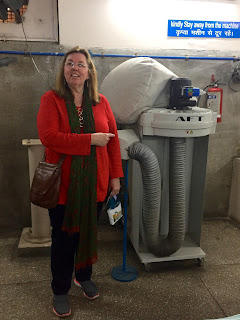Contributed by David Stovall
We see WHO today!
Early morning team breakfast, then we are on the road, leaving the hotel around 7:45 a.m. for a visit to the World Health Organization (WHO).
 |
| Zone 34 NID Team Members |
As an aside, the WHO is located in a basement of a much larger building and no identifying signs in the building designating the WHO. I privately wondered if that was a security issue.
 |
| Joint Team Meeting for Zones 33-34 |
 |
| Depiction of the 3 types of polio |
 |
| Dr. Bhatnagar addressing the Teams |
Traffic in New Delhi is amazing, to say the least. In 3 days of 'out and about' now, however, I have yet to see a fender bender. Auto Rickshaws-yellow, tri-wheeled, and two passenger, dominate the streets as the preferred method of inner city transportation.
Some of the roads have striped lanes, but no one really pays attention to the lines if they are striped. It's so entertaining to watch AND hear, as there is so much 'honking' of the horns.
Wikipedia ranks New Delhi at the sixth largest city on the planet, with a metropolitan area population of +45 million.
Enabling the Differently Abled
The last case of polio in India was in January of 2011...
Next, we toured the St. Stephens Hospital, which has existed since 1885. The private hospital has a dedicated Polio reconstructive ward which is sponsored by one of the Delhi Rotary clubs. Currently, there are 8 females and 3 males in the ward. They are pre-2012 cases who are having reconstructive procedures.
 |
| A separate Rotary Foundation project in the hospital. |
 |
| Dr. Mathew Varghese |
The most common muscle paralyzed by polio is the quadricep. The aim of surgery here is to make a paralyzed child as independent as possible.
Immersed in the Culture & People
I am completely intrigued with the traffic in Delhi. Here are some more examples.
Delhi gate is from the 12th century.
Turquamn Gate also dates from the 12th century. Also, note the Delhi Stock Exchange on the far right. Delhi has been the capital of 7 dynasties, and means 'heart' as it is in the heart of India.

Near the end of the day was a rickshaw ride through Old Delhi. I must admit, it was a bit unnerving. Each block of several avenues each specialize in a different commodity.

The tour guide joked that there is even a block for auto parts. 'you can come within an hour of an auto part theft and buy your part back...at a discount!' I THINK she was joking?
Last stop for the day was the Shaji Jama Masijd built by the
Emporer in 1656AD.
 |
| While everyone had to remove their shoes in the mosque, the ladies had to don gowns. |
David Stovall
















Looks like a memorable and long day. That's the best part of NID visit always.
ReplyDeleteI am happy our coordination finally worked with Stephen Hospital, we started it few months back and good we blocked two days,it's joy to meet Dr. Mathew Varghese always.